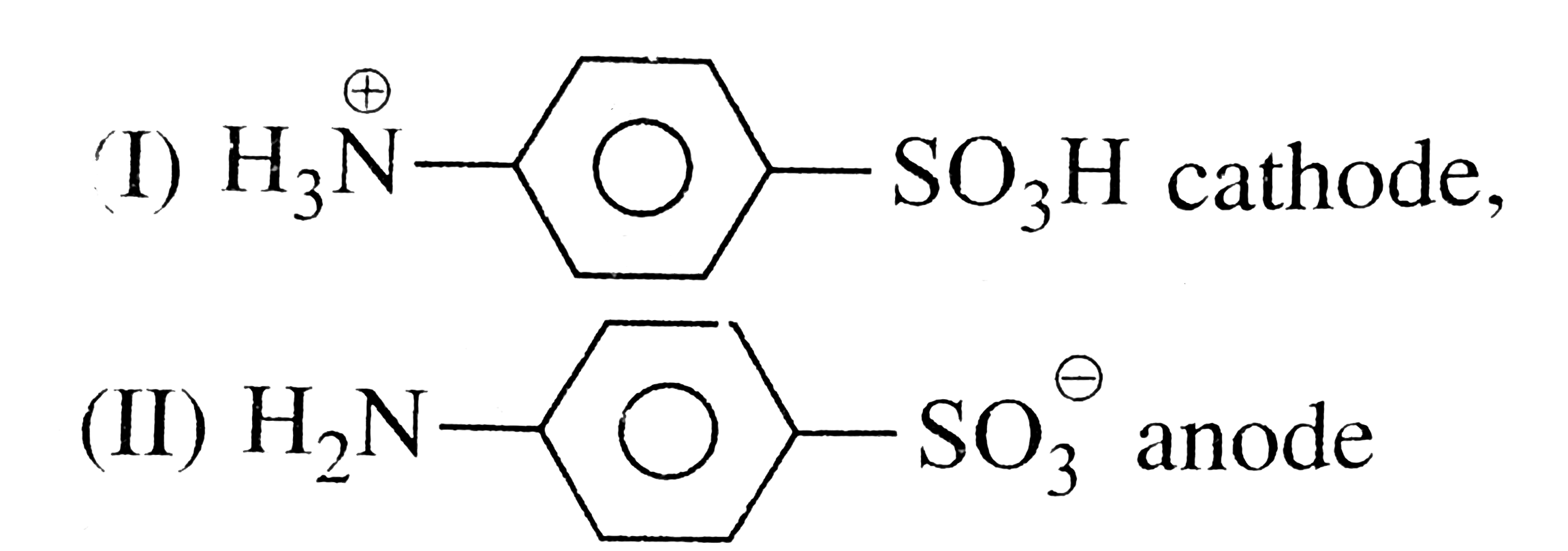Sulfanillic acid at pH=2 and 12 exists as....and migrates towards..... Respectively.

(II) anode and (I) carhode
At both pH, only (I) and migrates towards the cathode
At both pH, only (II) and migrates towards the anode
The correct Answer is:a
To solve the problem regarding the behavior of sulfanillic acid at different pH levels, we will analyze the structure of sulfanillic acid and how it interacts with the surrounding environment at pH 2 and pH 12.
1. Understanding the Structure of Sulfanillic Acid:
- Sulfanillic acid has the following structure:
- An amino group (-NH2)
- A sulfonic acid group (-SO3H)
- The overall structure can be represented as:
NH2∣SO3H
2. Analyzing at pH 2:
- At pH 2, the environment is acidic. This means there are excess H⁺ ions present.
- The amino group (-NH2) can accept a proton (H⁺) from the solution, becoming positively charged (-NH3⁺).
- Therefore, at pH 2, sulfanillic acid exists primarily in its cationic form:
NH3⁺∣SO3H
3. Migration of the Cation:
- Cations (positively charged species) migrate towards the cathode in an electrochemical cell because the cathode is negatively charged.
- Thus, at pH 2, sulfanillic acid exists as a cation and migrates towards the cathode.
4. Analyzing at pH 12:
- At pH 12, the environment is basic. This means there are excess OH⁻ ions present.
- The OH⁻ ions can deprotonate the sulfonic acid group (-SO3H), leading to the formation of a negatively charged sulfonate ion (-SO3⁻).
- Therefore, at pH 12, sulfanillic acid exists primarily as an anion:
NH2∣SO3⁻
5. Migration of the Anion:
- Anions (negatively charged species) migrate towards the anode in an electrochemical cell because the anode is positively charged.
- Thus, at pH 12, sulfanillic acid exists as an anion and migrates towards the anode.
Final Answer:
- At pH 2, sulfanillic acid exists as a cation and migrates towards the cathode.
- At pH 12, sulfanillic acid exists as an anion and migrates towards the anode.
Summary:
- pH 2: Cation → Migrates towards Cathode
- pH 12: Anion → Migrates towards Anode
- Sulfanillic acid has the following structure:
- An amino group (-NH2)
- A sulfonic acid group (-SO3H)
- The overall structure can be represented as:
NH2∣SO3H
- At pH 2, the environment is acidic. This means there are excess H⁺ ions present.
- The amino group (-NH2) can accept a proton (H⁺) from the solution, becoming positively charged (-NH3⁺).
- Therefore, at pH 2, sulfanillic acid exists primarily in its cationic form:
NH3⁺∣SO3H
- Cations (positively charged species) migrate towards the cathode in an electrochemical cell because the cathode is negatively charged.
- Thus, at pH 2, sulfanillic acid exists as a cation and migrates towards the cathode.
- At pH 12, the environment is basic. This means there are excess OH⁻ ions present.
- The OH⁻ ions can deprotonate the sulfonic acid group (-SO3H), leading to the formation of a negatively charged sulfonate ion (-SO3⁻).
- Therefore, at pH 12, sulfanillic acid exists primarily as an anion:
NH2∣SO3⁻
- Anions (negatively charged species) migrate towards the anode in an electrochemical cell because the anode is positively charged.
- Thus, at pH 12, sulfanillic acid exists as an anion and migrates towards the anode.
- At pH 2, sulfanillic acid exists as a cation and migrates towards the cathode.
- At pH 12, sulfanillic acid exists as an anion and migrates towards the anode.
- pH 2: Cation → Migrates towards Cathode
- pH 12: Anion → Migrates towards Anode
Topper's Solved these Questions
- AROMATIC COMPOUNDS AND ALKYL AND ARYL HALIDES BOOK - CENGAGE CHEMISTRY ENGLISHCHAPTER - AROMATIC COMPOUNDS AND ALKYL AND ARYL HALIDES EXERCISE - Exercises Multiple Correct Answers Type
15 Videos
- AROMATIC COMPOUNDS AND ALKYL AND ARYL HALIDES BOOK - CENGAGE CHEMISTRY ENGLISHCHAPTER - AROMATIC COMPOUNDS AND ALKYL AND ARYL HALIDES EXERCISE - Exercises Single Correct Answer Type
28 Videos
- AROMATIC COMPOUNDS AND ALKYL AND ARYL HALIDES BOOK - CENGAGE CHEMISTRY ENGLISHCHAPTER - AROMATIC COMPOUNDS AND ALKYL AND ARYL HALIDES EXERCISE - Exercises Linked Compreshension Type
11 Videos
- APPENDIX INORGANIC VOLUME 2BOOK - CENGAGE CHEMISTRY ENGLISHCHAPTER - APPENDIX INORGANIC VOLUME 2EXERCISE - Short Answer Type
179 Videos
- BIOMOLECULESBOOK - CENGAGE CHEMISTRY ENGLISHCHAPTER - BIOMOLECULESEXERCISE - Exercises Archives (Analytical And Descriptive)
8 Videos
Similar Questions
Cations migrate towards it .
View SolutionAt pH=4, glycine exists as:
View SolutionBoth PH3 and PH5 exist .
View SolutionFor a acid 'A' pH =2 and for acid 'B' pH is 4. Then
View SolutionDuring electrolysis of an aqueous solution of sulphuric acid between platinum electrodes, two types of anions migrate towards anode but only one of them is discharged.
Name the product at the cathode and write the reaction.
View SolutionDuring electrolysis of an aqueous solution of sulphuric acid between platinum electrodes , two types of anions migrate towards anode but one of them is discharged (oxidised ).
Name the anion which is discharged at the anode .
View SolutionDuring electrolysis of an aqueous solution of sulphuric acid between platinum electrodes, two types of anions migrate towards anode but only one of them is discharged.
Do you notice any change in colour ? State why?
View SolutionDuring electrolysis of an aqueous solution of sulphuric acid between platinum electrodes , two types of anions migrate towards anode but one of them is discharged (oxidised ).
Name these two anions .
View SolutionDuring electrolysis of an aqueous solution of sulphuric acid between platinum electrodes, two types of anions migrate towards anode but only one of them is discharged.
Name the main product of the discharge of anion at the anode and write the anode reaction.
View SolutionDuring electrolysis of an aqueous solution of sulphuric acid between platinum electrodes , two types of anions migrate towards anode but one of them is discharged (oxidised ).
Name of the main product of the discharge of anion at anode and write the anode reaction .
View Solution
